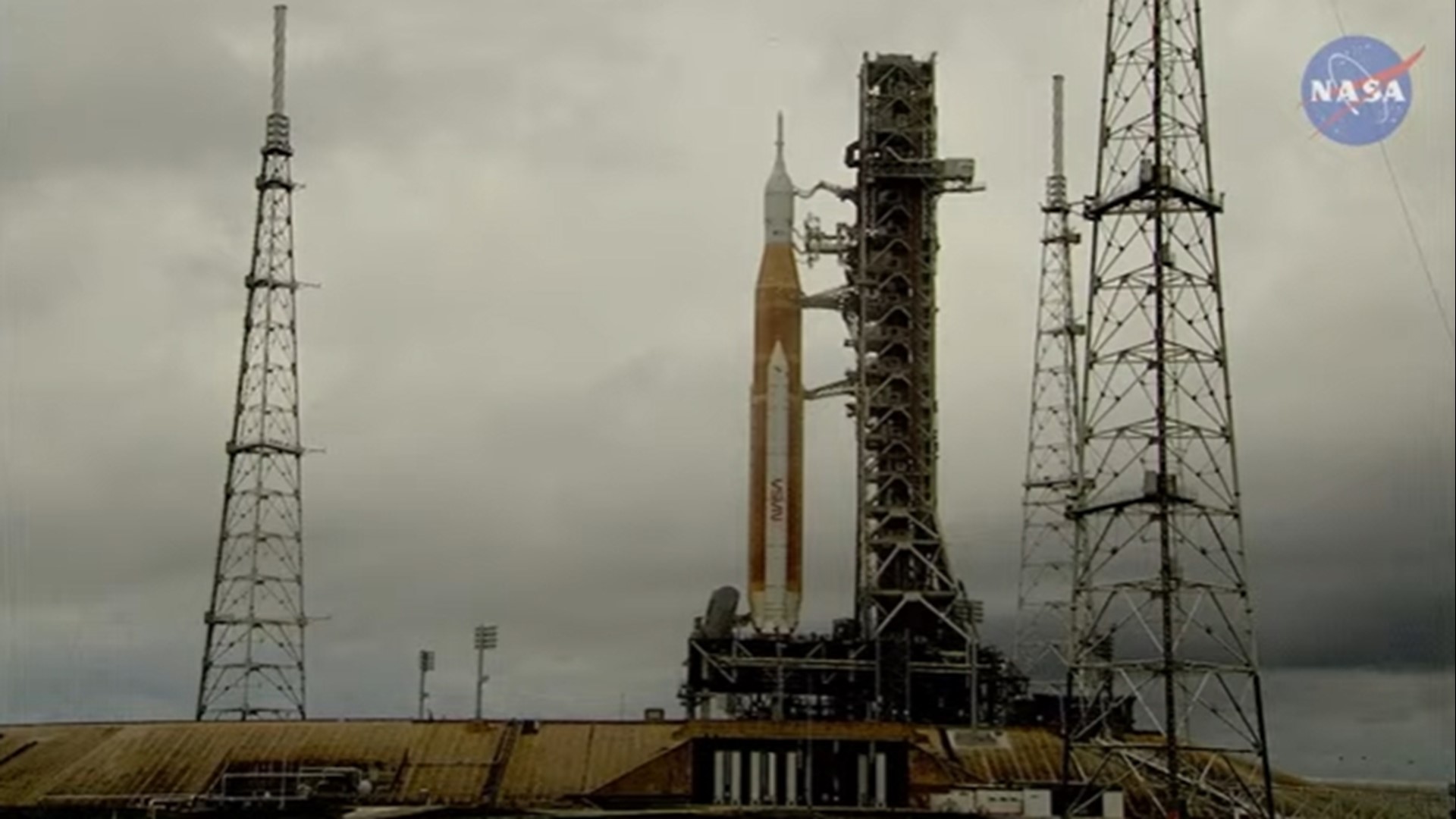DECATUR, Ala. — It’s T minus 2 days until NASA rolls out the Orion Capsule which will eventually hold four astronauts, and The Space Launch System (SLS), produced here in the Tennessee Valley.
However, have you ever wondered about the size and scope of the rocket?
FOX54 Keneisha Deas has some fun facts for you!
Let’s take for example the height of the Space Launch System, the rocket that will launch the crew to the moon.
It’s almost twice as tall as the tallest Huntsville building, the Regions Tower downtown which is (189 ft).
The SLS is 322 feet.
It’s almost twice as tall as Birmingham's Vulcan, on its pedestal. What about the propellant that fuels this SLS rocket? It takes 700,000 gallons!
Just imagine, the Bryant Denny Stadium in Tuscaloosa holds a little more than 100,000 people.
If every person held a gallon, it would take seven stadiums total to amount to the number of gallons used to fill the SLS rocket.
How does the SLS travel? In pieces, on barges. The Core Stage, where liquid fuel goes, is 212 feet long. It floats on a special-modified barge longer than a football field (310 feet). An average fishing boat is about 21 feet long, so you'd have to put about 15 end-to-end to equal that barge.
What about the power of the SLS compared to the Saturn V rocket used in the Apollo mission?
The SLS, although smaller than the Saturn V, has 13% more thrust.
It can take more cargo to the moon more than 238 thousand miles away than the space shuttle could take to low earth orbit, about 1,200 miles.
With great power, comes great speed.
A golf ball launched at top pro tour speed would have to travel for 58.8 days to reach the moon. The SLS will get astronauts there in 8-14 days.
How are the astronauts traveling? Well, more comfort than those in the Apollo mission.
The Apollo module carried three people and had 210 cubic feet. The Orion spacecraft has a volume of roughly 316 cubic feet and has space for 4 people.
Just for some perspective, a typical compact car has about 100 cubic feet of passenger space.
=============================================================
It’s a big week for NASA as they prepare to launch the uncrewed Artemis I. The Marshall Space Flight Center in Huntsville is a mega part of it by producing the 322 foot Space Launch System for liftoff.
FOX54’s Keneisha Deas caught up with the director in Decatur Monday on launch preparations!
On Thursday afternoon, St. Patrick’s Day, the team will be in Cape Canaveral at the Kennedy Space Center for the rollout of the Orion capsule and SLS.
“We are ready to roll to the pad,” said NASA’s Marshall Space Flight Center Director, Jodi Singer.
Once the Orion capsule and SLS are at the pad, NASA will proceed with what’s called a ‘wet dress rehearsal’.
“What we do is we load over 700,000 gallons of propellant into the Space Launch System. And we do literally a countdown where we go and make sure that the systems are talking that the whole vehicle the Orion capsule and the Space Launch System are talking not only to each other but that they're talking to the into the launch pad. And so that when we are ready to push the button and go. It will be going!,” added Singer.
How much fuel is 700,000 gallons?
- An Olympic-sized swimming pool holds about 660,000 gallons of water.
- The average backyard swimming pool holds about 20,000 gallons of water.
- If you drank a gallon of water a day, it would take 1,917 years to drink 700,000 gallons.
- An average shower uses 17.2 gallons of water. That means there are 40,697 showers worth of fuel.
- Grab a five-gallon bucket, or rather, 140,000. That's how many you'd need to hold the SLS launch fuel.
- The average U.S. car's gas tank holds 19 gallons. The SLS holds 36,842 fill-ups of fuel...but we don't suggest using it in your car.
Singer said the ‘wet dress rehearsal’ is critical in order for NASA to know what to expect when they’re ready to launch. “After the wet dress will roll back into the Vehicle Assembly Building. We'll check it out to make sure that all the systems are still good. There's a little bit of extra work that we have to do getting it ready for its launch. So the next time we roll to the pad then that will be when we're launching it.”
Singer says they are shooting for a window between late May to Early June for the real launch.
But, there are other factors to consider. “You have to look at the launch window. How is the Earth and the Moon aligned? What is the weather? The conditions we want to launch under? And so we have to take safety as well as physics into account.”
The Artemis mission will eventually send the first woman and first person of color to the moon.
Singer, being the first female Director of Marshall Space Flight Center, is excited. “Just a monumental phase of life. I have been blessed with a career working with space exploration for over 35 years. And I'll tell you I've got to work with the shuttle and it's fantastic. But I will tell you working with the Space Launch System and seeing the Artemis program and being part of returning us back to the moon is one of those things that is just a dream come true and all right.”

